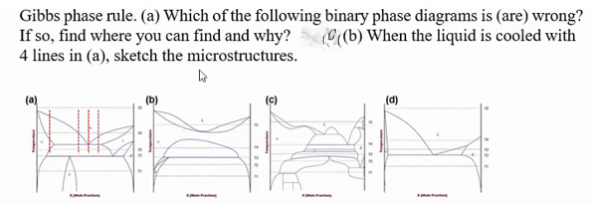4. The number of degrees of freedom (F) which a system containing C components can have when P phases are in equilibrium is given by F= C-P+2, called as the
4. The number of degrees of freedom (F) which a system containing C components can have when P phases are in equilibrium is given by F= C-P+2, called as the
Physical Chemistry
2nd Edition
ISBN:9781133958437
Author:Ball, David W. (david Warren), BAER, Tomas
Publisher:Ball, David W. (david Warren), BAER, Tomas
Chapter7: Equilibria In Multiple-component Systems
Section: Chapter Questions
Problem 7.57E
Related questions
Question

Transcribed Image Text:Gibbs phase rule. (a) Which of the following binary phase diagrams is (are) wrong?
If so, find where you can find and why? (((b) When the liquid is cooled with
4 lines in (a), sketch the microstructures.
↳

Transcribed Image Text:4. The number of degrees of freedom (F) which a system containing C components
can have when P phases are in equilibrium is given by F= C-P+2, called as the
Expert Solution
This question has been solved!
Explore an expertly crafted, step-by-step solution for a thorough understanding of key concepts.
Step by step
Solved in 2 steps

Knowledge Booster
Learn more about
Need a deep-dive on the concept behind this application? Look no further. Learn more about this topic, chemistry and related others by exploring similar questions and additional content below.Recommended textbooks for you

Physical Chemistry
Chemistry
ISBN:
9781133958437
Author:
Ball, David W. (david Warren), BAER, Tomas
Publisher:
Wadsworth Cengage Learning,

Introductory Chemistry: A Foundation
Chemistry
ISBN:
9781337399425
Author:
Steven S. Zumdahl, Donald J. DeCoste
Publisher:
Cengage Learning

Physical Chemistry
Chemistry
ISBN:
9781133958437
Author:
Ball, David W. (david Warren), BAER, Tomas
Publisher:
Wadsworth Cengage Learning,

Introductory Chemistry: A Foundation
Chemistry
ISBN:
9781337399425
Author:
Steven S. Zumdahl, Donald J. DeCoste
Publisher:
Cengage Learning